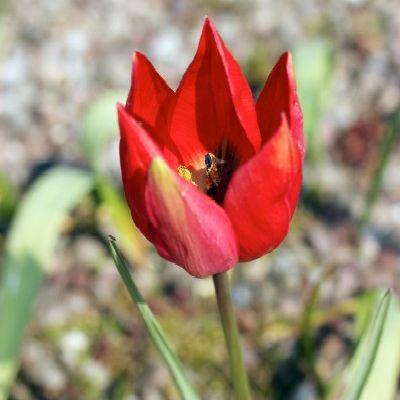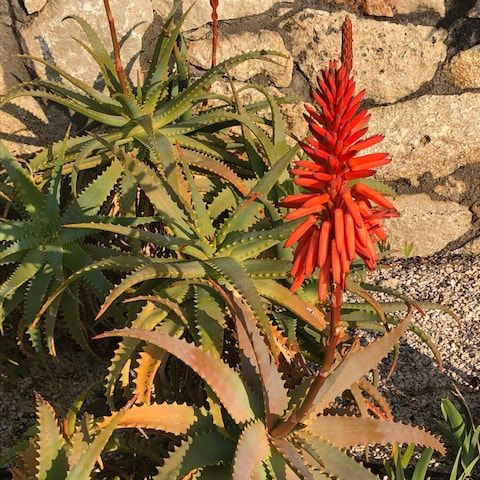Members’ Photographs of Mediterranean-Climate Plants at Home and Abroad

Mediterranean gardening can be challenging with no rain for three or four months of the year and temperatures in the high 30’s centigrade followed by,
often very wet, winters in the low minuses. Often the soil is free-draining, which is difficult if you are also trying to be water-wise.
Here we encourage members to share photographs of plants flowering in their own Mediterranean-climate gardens. We all enjoy visiting other gardens, often picking up ideas for our own and our new gallery page will only work with your help and your photographs. Photographs will be featured monthly with a plant of the month to create a catalogue of what flowers, when.
Any plant in a garden or any wild flower in a Mediterranean-climate countryside, is welcome, even if you have no name, we should be able to identify it. We love to have exchange between members so, please do email photos.
Sending Photographs
A close-up is best with a description of the flowering situation. The largest resolution file you can send is best for clarity when putting photographs on the internet. Images should have as many of the following details as possible but don’t worry if you don’t have all this info:
The month, plant name and area where the photograph was taken. Any other information you have about it is interesting to have.
January

Narcissus papyraceus
Height: to 35cm
Flower: strongly scented
Well-known paperwhite narcissus carries up to ten flowers in early to late spring.
Happy in all soils in full sun or shade and found across the Mediterranean and south west Europe

Iris unguicularis (formerly I. stylosa)
Height: 30cm
Spread: to 0.5m
Flowers: very fragrant
Winter low -5C
Also known as the Algerian iris, native to Greece, Turkey, western Syria and Tunisia. Its natural habitat being lightly shaded and rocky. It thrives on neglect and thin soil. In Britain it needs full sun and dry, stony alkaline soil. At the foot of a sunny wall is a good choice.

Solandra grandiflora
Greece, Peloponnese.
Winter low -2C
+50m but easily kept within bounds
happy in poor soil
occasional watering
Not a Mediterranean plant but very definitely worthwhile growing this vigorous climber for its huge pale yellow flowers which continue appearing until May in our area. It seems to enjoy being cut back.
February

Iris tuberosa Syn: Hermodactylus tuberosus
Agios Spiridona, Peloponnese
Winter low -5C
Height: 30-35cm
Poor well-drained soil
No extra water. Needs summer baking.
Native to the Mediterranean. Spreads easily and has a delightful scent which intensifies in the sun.

Coronilla valentina ssp glauca, UK
Height: 0.5 – 1m
Spread: 0.5 – 1m
Soil: Any
Scented flowers
Water: well-drained but moist
Coronilla valentina ssp glauca is a true native of the Mediterranean but is photographed here growing very happily in Edinburgh, where it flowers right through the winter. Garden centres often name it simply as Coronilla glauca, presumably for the convenience of customers. This is the variety ‘Citrina’, with lemon yellow flowers that contrast well with the small blue-green leaves.
Member Michael Turner says: “The books all say it needs a warm sheltered spot but we think it is more tolerant. It even offers a pleasing scent on a calm sunny day, though we do not have many of those in Edinburgh.”
March

Echium candicans
Isles of Scilly.
Winter low – frost tender
Height: 1.5 – 2.5m
Well-drained soil in sun.
A perennial which is semi-evergreen, will need protection in colder regions where it may also lose its leaves until Spring.
April

Tulipa doerfleri, UK
One of five endemic species of tulip on Crete, growing exclusively in Gious Kambos at an altitude between 700-800 metres. Endangered and protected since 1981.
Roger says: The bulbs were picked up from Spili Plateau (Gious Kambos) in autumn some years ago. Bulbs are lifted to the surface when fields are ploughed. Planted in ordinary garden soil, in a gravel-covered bed ten years ago, they have grown and multiplied. Though the species is reportedly sterile but some have migrated! The number of flowering plants varies: this year we had some damaged plants, possibly due to Lily Beetle.

Orchis italica, Naked man orchid
Spain
Height: to 50cm
Well-drained soil
Common throughout the Mediterranean and found usually in large colonies on scrubby land, often close to the sea.

Iris bismarckiana
Height: 30-50cm
Well-drained soil in full sun
Found on rocky, stony mountainsides at the edges of woodland or in scrub.
Happy on heavy limestone clays or chalky rocks. It needs high summer temperatures and dryness. This one was found in north-western Jordan by Oron,
is also called Nazareth iris. They form erect fans of leaves something similar to I. susiana.
May

Solanum riccartonii
Lefkada town, Ionian, Greece
Height: to 6m
A member of the potato family, (Solanaceae) native to South America.
Less hardy than S. ‘Glasnevin’. Vigorous growth but can easily be controlled by pruning in early spring.

Nectaroscordum siculum
Height: up to 1.2m
Any soil
Sun or shade
Self-seeds freely
A robust perennial with keeled basal leaves and a terminal umbel of nodding, long-stalked, bell-shaped flowers, beloved by bees. Colours combine cream, pink and green tints, followed by attractive, erect seed pods in late summer.
June

Scilla peruviana ‘Paul Voelker’
Height: 30 cm
Any soil
Scilla evergreen bulbs with narrow basal leaves and erect stems bearing racemes of star-shaped, flat or bell-shaped flowers which are often blue. Common name Cuban lily and Portuguese squill.

Teucrium ackermanii
Height: 15cm (6”)
Spread: 40cm (16”)
Soil: neutral to alkaline
Commonly known as silver germander, with silver grey linear leaves and scented purple pink flowers is very pretty falling over a rocky area. It is evergreen, drought and cold resistant down to -15°C and flowers throughout the summer.
July

Plumeria rubra
Height: up to 6m
Spread: 6m
Soil: well-drained, any pH
A slow growing tree native to southern Mexico and Florida but widely cultivated for its fragrant and attractive blooms. Deciduous with flowers beginning to show in June, opening in early July in Mediterranean regions and repeat all through the summer into autumn scenting the evening air.
August

Phlomis russeliana (seedhead)
Height: 60-90cm
Spread: 60cm
Soil: any, well-drained
Also called Turkish Sage. Evergreen shrubs with sage-like leaves and whorls of hooded, tubular flowers. Although still in flower in the UK across the Mediterranean the Phlomis is ready for seed collection.
Keep you eyes open for the many plants similarly in seed.
September

Yucca aloifolia
Height: 4.5+ m
Spread: 3+ m
Soil: well-drained
Drought resistant
Also know as Spanish dagger is a member of the Agavaceae family in the genus yucca. A multi-stemmed shrub or small tree can grow to 20m tall with a long, slender trunk and sword-like, leathery leaves. It is a native of south-eastern North America where it grows on sand dunes.

Cascabela thevetia (syn. Thevetia peruviana)
Height: 2m
Spread: 1m
Soil: Should not dry out, especially when in bloom
Temperature: to -10°C
Also known as Peruvian oleander a relative of Nerium oleander and a native of Mexico and South America. Like other oleanders all parts are poisonous. Flowers give a slight fragrance in the evening.
October

Bupleurum fruticosum
Height: 1.5m
Soil: Loam, Chalk
Common across southern Europe on sunny hills, walls and sunny places. Also known by the name shrubby hare’s ear. May be annual or perennial, evergreen blue-green leaves.
November

Cistanthe celosioides
The Atacama Desert, considered you be the driest place in the world (apart from the poles) this beauty has popped up after some rainfall.
December

Aloe arborescens
Height: 2.5m – 4m
Spread: 1m – 2.5m
Temp: down to -1C (30 F)
Originating from southern Africa. Bushy, multi-headed succulent shrub, also called deer-horn cactus. Long slender blue-green leaves have toothed margins.

